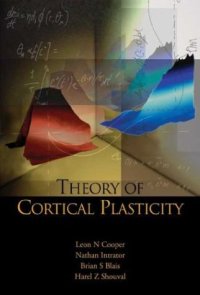
Ebook: Theory of Cortical Plasticity
- Year: 2004
- Publisher: World Scientific Publishing Company
- Language: English
- djvu
This is an important and interesting book that reviews some basic ideas about "cortical plasticity", which is the process that actually underlies intelligence and "mind". Cooper and his colleagues have made useful contributions over a long period of time, and most of their key ideas are covered in this book. There is also an admirable attempt to link models to experimental data.
But while they provide some important tools and ideas, they are very far from understanding their nominal topic. Partly this reflects their understandable attachment to their own pet idea, the famous "BCM" rule. This was originally intended to solve the standard problem of runaway synapse strengthening in a simple Hebb model (Oja came up with an even more elegant solution around the same time and place). But then they slowly realised that the nonlinear form of their rule also conferred useful sensitivity to input statistics that goes beyond the Oja model, and the book explains this advance quite nicely. But really there are 2 separate problems here: sensitivity to sophisticated statistics, and dynamical stabilisation, and it's not clear that BCM is the uniquely best solution to either. Furthermore, attempts to provide a secure mechanistic basis for the BCM rule have not been very convincing, in part because one really needs to use a framework ("STDP") that is much closer to biology.
While the authors focus on pet solutions to relatively easy and obvious problems, they completely miss the elephant in the cortical room: "crosstalk" between synapses means that no real synapses can actually learn from higher-order statistics unless much of cortex is devoted to crosstalk-mitigation. One very attractive possibility is that most cortical circuitry is actually devoted to a "proofreading" operation, that allows the unprecedented synaptic accuracy that underlies powerful computation and learning (see [...]). What matters is not the precise form of the learning rule, but its accuracy.
But while they provide some important tools and ideas, they are very far from understanding their nominal topic. Partly this reflects their understandable attachment to their own pet idea, the famous "BCM" rule. This was originally intended to solve the standard problem of runaway synapse strengthening in a simple Hebb model (Oja came up with an even more elegant solution around the same time and place). But then they slowly realised that the nonlinear form of their rule also conferred useful sensitivity to input statistics that goes beyond the Oja model, and the book explains this advance quite nicely. But really there are 2 separate problems here: sensitivity to sophisticated statistics, and dynamical stabilisation, and it's not clear that BCM is the uniquely best solution to either. Furthermore, attempts to provide a secure mechanistic basis for the BCM rule have not been very convincing, in part because one really needs to use a framework ("STDP") that is much closer to biology.
While the authors focus on pet solutions to relatively easy and obvious problems, they completely miss the elephant in the cortical room: "crosstalk" between synapses means that no real synapses can actually learn from higher-order statistics unless much of cortex is devoted to crosstalk-mitigation. One very attractive possibility is that most cortical circuitry is actually devoted to a "proofreading" operation, that allows the unprecedented synaptic accuracy that underlies powerful computation and learning (see [...]). What matters is not the precise form of the learning rule, but its accuracy.
Download the book Theory of Cortical Plasticity for free or read online
Continue reading on any device:

Last viewed books
Related books
{related-news}
Comments (0)